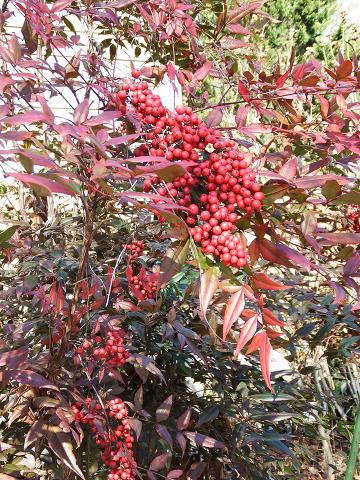Nandina Domestica is a killer

The beautiful but deadly nandina berries
Granny Gertrude's Garden
by Gertrude Weatherall
Nandinas have been planted for decades. They are chosen for their beautiful bright red berries or their equally attractive foliage. Often referred to as heavenly bamboo, sacred bamboo, or sacred shrub, these beautifully cloaked shrubs have been used extensively in landscape design. And why not? They are colorful, easy to grow, tough as nails, readily available and very inexpensive.
Beautiful red berries are produced within a couple seasons. The berries make beautiful additions to holiday arrangement or wreaths. Left on the shrubs, the berries are eaten by hungry birds. Could this shrub be any more appealing? Unfortunately, they are deadly.
Nandina is another plant that has been planted widely simply because it looks good. It is a non-native that thrives most everywhere in the Southeast. Easily escaping the confines of area yards, it now appears throughout forests. It gladly grows in wooded areas where birds have spread the berries.
Many birds die after ingesting the berries. These berries can be rich in cyanide. Entire flocks of cedar waxwing birds have been found with the berries in their stomachs.
How are the berries being carried to the wild? As the berries age and hang on the shrub they become less toxic. Thus, many are carried to the wild and successfully germinate. Our indigenous birds cannot tell which berries are toxic and which have aged enough to be safely eaten. For birds, it is much like a game of Russian roulette. As birds return year after year to the same feeding grounds, their chances of ingesting toxic berries increases. Perhaps this is one of the many reasons bird populations are being decimated?
Many nandina do not produce berries. The small cultivars, including Firepower, are grown exclusively for their foliage. They are beautiful red shrubs that reach about three feet high. This foliage stays red all winter. Chances are you have these in your landscape. I consider this one of most over-planted shrubs on the market today. Virtually every subdivision is filled with them. They are also very toxic, but an animal must ingest the foliage to become ill. They are still dangerous to pets, children or any other foliage-eating animal.
In addition to being toxic there are other reasons to avoid planting nandina. Lots of trimming is required to establish a decent shape. They spread rapidly, often out-competing natives. The beautiful red foliage drops when the new foliage appears in the spring. Who wants to clean up falling leaves when the spring flowers are blooming?
If you have these plants in your landscape, my advice is to kill them. Cut them down and burn them. Dig them out if possible, because they do not die without a fight. I am not found of using chemical herbicides, but for these demons I make an exception.
There are many nice alternatives to planting nandina. One of my favorites is Ilex Verticilata or deciduous holly. First, it is a native. A bounty of bird-friendly red or gold berries are produced, but a male cultivar may be necessary.
Cultivars exist that are short in stature, but the species is large, upwards to ten feet or more. These plants lose their leaves in the winter, exposing stems covered in beautiful red berries. I often use them in holiday arrangements, but the shrubs stand out in my garden. Many neighbors have stopped and inquired about the identity of my deciduous hollies. I have also known it to be referred to as winter berry holly. For several years I had no berries, only large imposing plants. The addition of a male cultivar provided me with thousands of berries the first year. A good man can make all the difference.
Another choice is beautyberry or Callicarpa Americana. These shrubs are shorter, also lose their leaves in the winter and produce attractive purple berries. They are nontoxic to wildlife and can be eaten in small quantities by humans. Birds love them. Those purple berries usually are at peak around Halloween which makes them perfect for fall arrangements.
Other berry-producing plants include roses, evergreen hollies, dogwood trees, magnolia, serviceberry and even blueberry. Blueberries are an untapped ornamental. They have beautiful fall foliage and edible fruit, but you will need to be faster than the birds.
Let’s start the new year out right. Ditch the invasives, focus on natives, and plant for the wildlife. I promise your garden will be a much happier place for both you and our wild friends.
- Log in to post comments